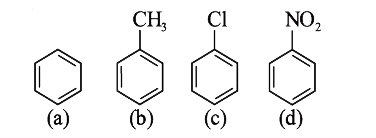The decresing order of reactivity towards SE (substitution by electrophile) of the following is :
(I) Nitrobenzene
(II) Chlorobenzene
(III) Toluene
(IV) Benzene.
(I)>(II)>(III)>(IV)
(IV)>(III)>(II)>(I)
(III)>(IV)>(II)>(I)
(I)>(II)>(IV)>(III)
The correct Answer is:C
To determine the decreasing order of reactivity towards electrophilic substitution (SE) for the compounds given (Nitrobenzene, Chlorobenzene, Toluene, and Benzene), we need to analyze the effects of the substituents on the benzene ring. Here’s a step-by-step breakdown of the reasoning:
Step 1: Identify the Compounds and Their Substituents
1. Nitrobenzene (I): Contains a nitro group (-NO2), which is a strong electron-withdrawing group.
2. Chlorobenzene (II): Contains a chloro group (-Cl), which is a weak electron-withdrawing group due to its -I effect.
3. Toluene (III): Contains a methyl group (-CH3), which is an electron-donating group.
4. Benzene (IV): The base structure without any substituents.
Step 2: Analyze the Effects of Substituents
- Toluene: The methyl group is an electron-donating group (EDG) that increases the electron density on the benzene ring, making it more reactive towards electrophiles. Thus, it is the most reactive.
- Benzene: The benzene ring has a delocalized electron cloud, which allows it to react with electrophiles, but it does not have any substituents that enhance or diminish its reactivity significantly. It is less reactive than toluene but more reactive than the others with electron-withdrawing groups.
- Chlorobenzene: The chloro group has a -I effect (inductive effect) that withdraws electron density from the ring, making it less reactive towards electrophilic substitution than benzene.
- Nitrobenzene: The nitro group is a strong electron-withdrawing group (-NO2), which significantly decreases the electron density on the benzene ring, making it the least reactive towards electrophilic substitution.
Step 3: Establish the Order of Reactivity
Based on the analysis:
1. Toluene (III) - Most reactive due to the electron-donating methyl group.
2. Benzene (IV) - Reactive but less than toluene.
3. Chlorobenzene (II) - Less reactive due to the weak electron-withdrawing effect of the chloro group.
4. Nitrobenzene (I) - Least reactive due to the strong electron-withdrawing effect of the nitro group.
Final Order of Reactivity
Thus, the decreasing order of reactivity towards electrophilic substitution is:
Toluene > Benzene > Chlorobenzene > Nitrobenzene
1. Nitrobenzene (I): Contains a nitro group (-NO2), which is a strong electron-withdrawing group.
2. Chlorobenzene (II): Contains a chloro group (-Cl), which is a weak electron-withdrawing group due to its -I effect.
3. Toluene (III): Contains a methyl group (-CH3), which is an electron-donating group.
4. Benzene (IV): The base structure without any substituents.
- Toluene: The methyl group is an electron-donating group (EDG) that increases the electron density on the benzene ring, making it more reactive towards electrophiles. Thus, it is the most reactive.
- Benzene: The benzene ring has a delocalized electron cloud, which allows it to react with electrophiles, but it does not have any substituents that enhance or diminish its reactivity significantly. It is less reactive than toluene but more reactive than the others with electron-withdrawing groups.
Based on the analysis:
1. Toluene (III) - Most reactive due to the electron-donating methyl group.
2. Benzene (IV) - Reactive but less than toluene.
3. Chlorobenzene (II) - Less reactive due to the weak electron-withdrawing effect of the chloro group.
4. Nitrobenzene (I) - Least reactive due to the strong electron-withdrawing effect of the nitro group.
Thus, the decreasing order of reactivity towards electrophilic substitution is:
Toluene > Benzene > Chlorobenzene > Nitrobenzene
Topper's Solved these Questions
- ORGANIC REACTION MECHANISMBOOK - CENGAGE CHEMISTRY ENGLISHCHAPTER - ORGANIC REACTION MECHANISMEXERCISE - Assertion-Reasoning
12 Videos
- ORGANIC REACTION MECHANISMBOOK - CENGAGE CHEMISTRY ENGLISHCHAPTER - ORGANIC REACTION MECHANISMEXERCISE - Archives
8 Videos
- ORGANIC REACTION MECHANISMBOOK - CENGAGE CHEMISTRY ENGLISHCHAPTER - ORGANIC REACTION MECHANISMEXERCISE - Multiple Correct
30 Videos
- NCERT BASED EXERCISEBOOK - CENGAGE CHEMISTRY ENGLISHCHAPTER - NCERT BASED EXERCISEEXERCISE - Chemical Equilibrium
73 Videos
- P-BLOCK GROUP 13 - BORON FAMILYBOOK - CENGAGE CHEMISTRY ENGLISHCHAPTER - P-BLOCK GROUP 13 - BORON FAMILYEXERCISE - Exercise Archives (Subjecive)
9 Videos
Similar Questions
Knowledge Check
The correct order of reactivity towards electrophilic substitution is
Abenzene > phenol > benzoic acid > chlorobenzeneBphenol > benzene > chlorobenzene > benzoic acidCchlorobenzene > benzoic acid > phenol > benzeneDbenzoic acid > chlorobenzene > benzenegtphenol.The decreasing order of reactivity of given compound towards nucleophilic substitution with aqueous NaOH is :
 AI gt II gt III gt IVBII gt I gt III gt ICIV gt II gt III gt IDII gt IV gt I gt III
AI gt II gt III gt IVBII gt I gt III gt ICIV gt II gt III gt IDII gt IV gt I gt III
Identify the correct of reactivity in electrophilic substitution reaction of the following compounds.
(1) Benzene
(2) Toluene
(3) Chlorobenzene,
(4) Nitrobenzene.
View SolutionThe correct order of reactivity towards the electrophilic substitiution of the compounds aniline(I),benzene(II) and nitro-benzene(III) is
View SolutionIdentify the correct order of reactivity in electrophilic substitution reactions of the following compounds :

View SolutionIdentify the correct order of the reactivity towards electrophilic substition of the following compounds .

View SolutionGive the decreasing order of the relative reactivity towards SE reaction of the following compounds.
a. I. Benzene, II. Phenol, III. Aniline, IV. Chlorobenzene
View SolutionArrange the following in decreasing order of reactivity towards electrophilic substitution reaction
Aniline (I) , Acetanilide (II)
phenol (III) , Anilinium chloride (IV)
View Solution

_CHE_E06_235_Q01.png)